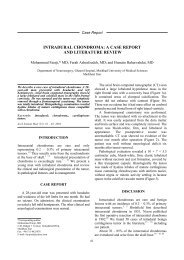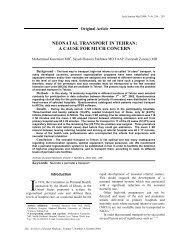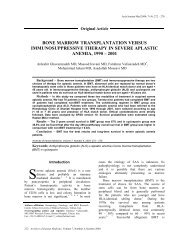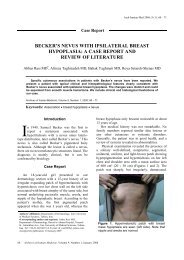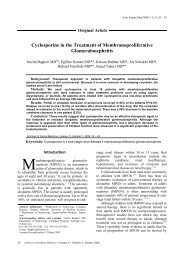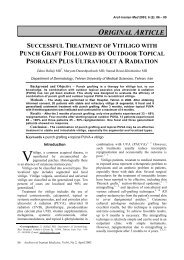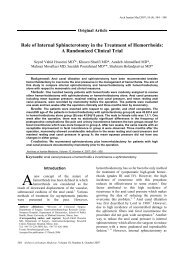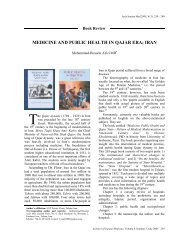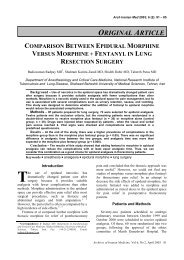The Rey Auditory Verbal Learning Test
The Rey Auditory Verbal Learning Test
The Rey Auditory Verbal Learning Test
You also want an ePaper? Increase the reach of your titles
YUMPU automatically turns print PDFs into web optimized ePapers that Google loves.
M. Rezvanfard, H. Ekhtiari, M. Noroozian, et al.guidelines. 16 Only the most frequent words were used becauseof word usage and the likelihood of recall effect. 17• <strong>The</strong> imagery value using Pavio’s Table. 18 Words withhigh rates of imagery value were selected.• Word length measured by the number of letters and syllables.Only one- or two-syllable nouns were used to generatethe lists.• Control of any obvious semantic ambiguity and/or phoneticsimilarities or associations between the words on thesame list.<strong>The</strong> assessment of change is often critical in the neuropsychologicalevaluation, whether in research or in clinicalsettings. <strong>The</strong> repeated use of instruments confounds this assessmentinasmuch as practice effects (gains in performanceby prior experiences with the test) have been demonstratedfor many measures. 19,20 Practice effects are particularly expectedwith memory testing on account of the fact that thelearning gained during the preliminary evaluations tends tobe transferred to the following ones. 14 A practice effect maybe related to the fact that patients explicitly remember testitems or the testing format (test sophisticated effects) previouslypresented. 21 It is possible to minimize the practice effectby using alternate forms of a test instead of retesting bythe same form. 9,20 Several alternative forms have been developedfor the RAVLT such as those created by: Lezak; Shapiroand Harrison; Crawford et al.; Majdan et al.; and Geffenet al. 1,14,15,22 <strong>The</strong>y have been proven useful, particularly inlongitudinal or sequential research designs where baselineperformance, experimental manipulation, and recovery timeare expected to feature within clinical populations.Measurement error is another effect of signicance in sofar as it can bafe a patient’s actual score in a test-retest designeven when alternative forms are employed. Measurementerror is often construed as the concept of reliability,which incorporates test-retest reliability (TRR). A score witha good TRR is free of measurement error unrelated to chancevariance, and the second session of testing is likely to resultin subjects having scored the highest remaining amongst thebest. 20 It is also worthy of note that highly signicant reliabilitycoefcients were reported while studying different14, 20, 22alternative lists of the RAVLT.<strong>The</strong> present study aimed at developing a Persian version ofthe original word list of the RAVLT and two other alternateword lists from Lezak and Shapiro & Harisson, taking intoaccount the linguistic criteria specic to the Persian cultureand language settings. Practice effect was measured usingdifferent word lists at different retest intervals and alternateform reliability coefcients were evaluated for each trial.Materials and MethodsParticipantsNinety volunteers ages 18 to 50 (29.75±7.10 years) participatedin the study after providing written informed consent.<strong>The</strong> study population was comprised of 44 men and 46women, with educational levels ranging from 2 to 20 years(11.56±4.91). <strong>The</strong> exclusion criteria were history of brainsurgery or psychiatric symptoms and any type of medicalcondition or using a medication that might affect cognitivefunctioning.Word selection procedures<strong>The</strong> participants were assessed using the Persian adaptedlist of the RAVLT and two other alternate forms, (Lezak andShappiro & Harisson), based on the original English wordlists reviewed by Hawkins et al. (2004). 14 <strong>The</strong> original Englishwords, presented in Table 1, were initially translated intoPersian without any change. Of the 90 words from the sixoriginal English word lists, 80 which were in accordancewith desired linguistic criteria were retained from both listsA and B. Ten new words adapted to the Persian languagewere chosen for the development of the Persian lists. Finally,the word items on these newly formed Persian lists werecompared with the original lists for consistency in terms ofword length (as measured by number of phoneme counts inPersian), and all were one- or two-syllable concrete nouns.<strong>The</strong>re were no obvious semantic or phonetic associationsor similarities between the words on the same list and theywere chosen from amongst frequently occurring words inthe Persian language. <strong>The</strong> probability of the occurrence ofthe word in common usage in the Persian language was ascertainedusing the World Wide Web (WWW) as a database(from six billion contemporary Persian words on four millionwebsites), Google as the search engine, and a Googlebasedapplet, which provided word counts on the Webpages. This method was also employed by Cilibrasi (2007) 23to automatically compute the similarity distance betweenwords and phrases, and its performance was in agreementwith that of the Word Net database. Recognition lists wereconstructed using target words and adding 20 new semanticallyassociated or phonetically similar words as distracters.<strong>The</strong> above criteria helped establish form equivalence betweenthe three new lists.ProcedureAll tests were administered by qualied examiners (psychologyexperts) trained in AVLT administration at quiet locationsin accordance with Lezak’s instructions. 1 <strong>The</strong> participantswere screened at the beginning of the testing sessionfor exclusion criteria such as health problems via a standardizedinterview before being categorized into three groups of30 persons and matched based upon demographic variablesthat might affect performance on the auditory learning testsuch as age, gender, and education level. 6,24<strong>The</strong> rst group was tested based upon the Persian adaptedversion of <strong>Rey</strong>’s (word list 1) in two test sessions with intersessionintervals of 30 days (±3); the second group receivedthe <strong>Rey</strong>’s 60 days (±5) after the initial testing; andArchives of Iranian Medicine, Volume 14, Number 2, March 2011 105



